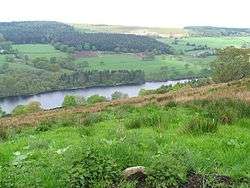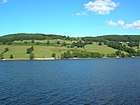Dale Dike Reservoir
Dale Dike Reservoir or Dale Dyke Reservoir (grid reference SK240913) is a reservoir in the north-east Peak District, in the City of Sheffield, South Yorkshire, England, a mile (1.6 km) west of Bradfield and eight miles (13 km) from the centre of Sheffield, on the Dale Dike, a tributary of the River Loxley.
| Dale Dike Reservoir | |
|---|---|
 Dale Dike Reservoir (dam) | |
| Location | Sheffield |
| Coordinates | 53.41796°N 1.64036°W |
| Type | reservoir |
| Primary inflows | Dale Dike |
| Primary outflows | Dale Dike |
| Catchment area | 4,010 acres (1,623 ha) |
| Basin countries | United Kingdom |
| Surface area | 58 acres (23.4 ha) |
| Average depth | 29 feet (8.8 m) |
| References | [1] |
Along with three other reservoirs around the village of Bradfield – Agden, Damflask and Strines – it was constructed between 1859 and 1864 by the Sheffield Waterworks Company to guarantee a supply of water to power the mills downstream and to supply drinking water to the growing population of Sheffield.[2] The architect was John Gunson.[3]
Great Sheffield Flood

The original dam was constructed to a height of 95 feet (29 m) by John Towlerton Leather, and was completed by April 1863.[4] The dam head had a puddle clay core and had a max volume of 114 million cubic feet (3,240×103 m3).[4] Filling took place soon after, and by the 10 March 1864, the water level was 2 feet 4 inches (0.7 m) below the crest of the dam.[5]
At 23:30 on 11 March 1864, the day after the reservoir was finally full, the newly built dam failed.[5] Over 690 million imperial gallons (3.1 Gl) of water cascaded down the valley causing the Great Sheffield Flood, which caused massive damage downstream along the Loxley and Don and through the centre of Sheffield, destroying over 5,000 properties and killing 244 people.[6][7][8]
The new dam
The dam was rebuilt in 1875, some 980 feet (300 m) upstream of the previous dam head,[9] and is still in use, holding 72,860,000 cubic feet (2,063,200 m3) of water, now used exclusively for domestic purposes.[1][10] It is owned by Yorkshire Water, part of the Kelda Group.[11]
References
| Wikimedia Commons has media related to Dale Dike Reservoir. |
- "Dale Dike Reservoir". eip.ceh.ac.uk. Retrieved 5 August 2020.
- "A Complete History of the Great Flood at Sheffield". Archived from the original on 20 October 2007. Retrieved 5 September 2006.
- "Meet The Gunsons". Archived from the original on 10 March 2016. Retrieved 1 December 2015.
- Charles, Tedd & Warren 2011, p. 57.
- Charles, Tedd & Warren 2011, p. 12.
- "Bradfield historical society" (PDF). Archived (PDF) from the original on 9 August 2016. Retrieved 2 August 2016.
- "Bradfield and the Dale Dike Dam Disaster". Archived from the original on 7 September 2011. Retrieved 28 November 2011.
- Wright, Oliver (11 March 2014). "The forgotten flood that deluged a city". BBC News. Retrieved 5 August 2020.
- Charles, Tedd & Warren 2011, p. 58.
- "Dale Dike Reservoir". environment.data.gov.uk. Retrieved 5 August 2020.
- Plimmer, Gill (3 December 2017). "Yorkshire Water investors look to sell £4bn stakes". Financial Times. Retrieved 5 August 2020.
Sources
- Charles, Andrew; Tedd, Paul; Warren, Alan (August 2011). Lessons from historical dam incidents (Report). Bristol: Environment Agency. ISBN 978-1-84911-232-1.
